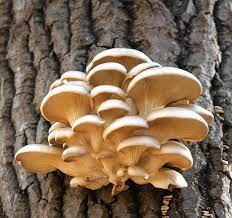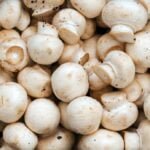Pleurotus ostreatus Mushroom
Among the plethora of mushroom species, Pleurotus ostreatus Mushroom, commonly known as the oyster mushroom, stands out as a versatile and intriguing fungus. In this exploration, we delve into the characteristics, cultivation, culinary uses, and potential health benefits of Pleurotus ostreatus Mushrooms, uncovering the secrets behind its popularity.
Taxonomy and Morphology
Pleurotus ostreatus Mushroom belongs to the Pleurotaceae family and is widely distributed in temperate and subtropical regions across the globe. This saprophytic mushroom is renowned for its distinctive oyster-shaped cap, which measures anywhere from 5 to 25 centimeters in diameter. The cap’s color can vary, ranging from white to shades of pink, yellow, or brown, depending on the strain and environmental conditions.
The gills beneath the cap are densely packed and radiate from the mushroom’s point of attachment, resembling the shape of oyster shells—hence the common name, oyster mushroom. The stem is often off-center and laterally attached to the cap. Overall, the appearance of Pleurotus ostreatus Mushroom is both aesthetically pleasing and easily recognizable, making it a popular choice for amateur and professional mycologists alike.
Culinary Uses
One of the primary reasons for Pleurotus ostreatus Mushrooms popularity is its delectable taste and versatile culinary applications. This mushroom boasts a mild, anise-like flavor and a tender, meaty texture, making it a favorite ingredient in various cuisines around the world.
- Cooking Techniques: Pleurotus ostreatus can be prepared using a variety of cooking techniques, including sautéing, grilling, roasting, and stir-frying. Its ability to absorb flavors from other ingredients makes it a versatile addition to soups, stews, pasta dishes, and more.
- Flavor Complement: The mild and adaptable taste of oyster mushrooms allows them to complement a wide range of ingredients, enhancing the overall flavor profile of a dish. Whether paired with garlic and herbs or incorporated into creamy sauces, Pleurotus ostreatus adds a unique and delightful dimension to culinary creations.
- Plant-Based Cuisine: Oyster mushrooms are a popular choice among those embracing plant-based diets. Their substantial texture and umami-rich taste make them a satisfying substitute for meat in various dishes, such as mushroom burgers, tacos, and even vegan scallops.
Cultivation of Pleurotus Ostreatus Mushroom
 While Pleurotus ostreatus Mushroom can be found in the wild, its cultivation has become increasingly popular due to its culinary value and economic potential. Cultivating oyster mushrooms is a rewarding endeavor that can be undertaken on a small scale at home or on a larger commercial scale.
While Pleurotus ostreatus Mushroom can be found in the wild, its cultivation has become increasingly popular due to its culinary value and economic potential. Cultivating oyster mushrooms is a rewarding endeavor that can be undertaken on a small scale at home or on a larger commercial scale.
- Substrates: Oyster mushrooms are known for their ability to grow on a wide range of substrates. Common substrates include straw, wood chips, and agricultural by-products like corn cobs and cottonseed hulls. This adaptability contributes to the mushroom’s versatility in cultivation.
- Cultivation Process: The cultivation process typically involves inoculating a substrate with Pleurotus ostreatus mycelium, allowing it to colonize and then inducing fruiting conditions. This can be achieved through methods such as bag cultivation, log cultivation, or growing on synthetic substrates. The relative simplicity of oyster mushroom cultivation has led to its popularity among both hobbyists and commercial growers.
- Harvesting: Oyster mushrooms are typically ready for harvest when the caps are fully expanded but before the gills begin to darken. Harvesting at the right time ensures optimal flavor and texture. The ease of identification and harvesting makes Pleurotus ostreatus an excellent choice for novice mushroom cultivators.
Health Benefits of the Pleurotus Ostreatus Mushroom
Beyond its culinary appeal, Pleurotus ostreatus Mushroom offers a range of potential health benefits, contributing to its growing popularity as a functional food.
- Nutrient Content: Oyster mushrooms are a rich source of essential nutrients, including protein, fiber, vitamins, and minerals. They are particularly notable for their high levels of B-vitamins, such as niacin and riboflavin, as well as minerals like potassium, phosphorus, and iron.
- Antioxidant Properties: Studies have suggested that oyster mushrooms possess antioxidant properties, attributed to compounds like ergothioneine and polyphenols. Antioxidants play a crucial role in neutralizing free radicals in the body, potentially reducing oxidative stress and inflammation.
- Immunomodulatory Effects: Some research indicates that certain bioactive compounds in oyster mushrooms may have immunomodulatory effects, influencing the activity of immune cells. While more research is needed in this area, the potential for immune system support adds to the mushroom’s appeal.
- Cholesterol-Lowering Potential: Preliminary studies suggest that Pleurotus ostreatus may have cholesterol-lowering effects. Beta-glucans, a type of soluble fiber present in oyster mushrooms, are believed to contribute to this potential benefit by interfering with cholesterol absorption in the digestive tract.
Pleurotus ostreatus, the oyster mushroom
In conclusion, Pleurotus ostreatus Mushroom, the oyster mushroom, captivates enthusiasts with its distinctive appearance, versatile culinary uses, and potential health benefits. Whether enjoyed as a delightful addition to various dishes, cultivated at home for personal consumption, or explored for its nutritional value, the oyster mushroom continues to be a fascinating subject of study and appreciation in the realms of mycology, gastronomy, and health. As our understanding of this remarkable fungus grows, so too does our appreciation for its contributions to our plates, our well-being, and the intricate ecosystems in which it thrives.
Cultivating Pleurotus ostreatus (Oyster Mushrooms): A Step-by-Step Guide
Growing Pleurotus ostreatus, commonly known as Oyster Mushrooms, at home can be a rewarding and relatively straightforward process. Whether you’re a novice or an experienced cultivator, follow these step-by-step instructions to cultivate your own batch of delicious and nutritious oyster mushrooms.
Materials and Equipment:
- Oyster mushroom spawn (mycelium): Purchase from a reliable supplier or prepare your own using a sterile culture.
- Substrate: Common choices include pasteurized straw, hardwood sawdust, or a mixture of the two. Substrates can also include supplements like gypsum and wheat bran.
- Sterilization equipment: Pressure cooker or autoclave to sterilize substrate and containers.
- Growing containers: Plastic bags or containers for holding the substrate and mycelium.
- Spawning tools: Clean gloves, mask, and a clean working environment to prevent contamination.
- Fruiting environment: Humid conditions, indirect light, and proper ventilation for the fruiting stage.
Step 1: Prepare the Substrate
Select and prepare your substrate. This can be a mixture of pasteurized straw and hardwood sawdust, with added supplements like gypsum and wheat bran. Sterilize the substrate to eliminate competing organisms, using a pressure cooker or autoclave.
Step 2: Inoculate with Mycelium
Once the substrate has cooled, inoculate it with oyster mushroom spawn. Break up the spawn into small pieces and evenly distribute it throughout the substrate. Ensure a clean and sterile environment during this process to prevent contamination.
Step 3: Incubation Period
Place the inoculated substrate in a clean, dark, and warm environment for the mycelium to colonize the substrate. Maintain a temperature between 75-80°F (24-27°C) during this incubation period, which typically lasts 2-4 weeks. The mycelium will grow and spread throughout the substrate.
Step 4: Prepare the Growing Containers
Once the substrate is fully colonized by the mycelium, transfer it into growing containers. Plastic bags with small holes or containers with breathable lids work well. Pack the substrate evenly in the containers, leaving some space for the mushrooms to grow.
Step 5: Initiate Fruiting Conditions
Expose the colonized substrate to fresh air, reduce temperature to 55-75°F (13-24°C), and provide indirect light. This change in conditions signals the mycelium to initiate fruiting. Mist the substrate regularly to maintain high humidity levels.
Step 6: Monitor and Maintain
As the mushroom pins start to form, continue misting to maintain humidity. Ensure proper ventilation to prevent excess carbon dioxide buildup. Oyster mushrooms are relatively low-maintenance, but consistent monitoring is essential.
Step 7: Harvesting
Harvest the oyster mushrooms when the caps are fully developed but before they flatten and the edges curl upwards. Use a clean knife or scissors to cut the mushrooms at the base. Harvesting should be done in batches as the mushrooms mature.
Step 8: Second and Subsequent Flushes
Oyster mushrooms are known for their ability to produce multiple flushes. After the first harvest, continue misting and maintaining fruiting conditions. The mycelium may produce additional crops of mushrooms in subsequent flushes.
Tips and Considerations:
- Sterility is Key: Maintain a sterile environment throughout the cultivation process to prevent contamination by unwanted microorganisms.
- Humidity Control: Oyster mushrooms thrive in high humidity. Regular misting is crucial during the fruiting stage to ensure optimal conditions for mushroom development.
- Ventilation: Provide adequate ventilation to prevent the buildup of carbon dioxide, which can inhibit mushroom growth.
- Lighting: While oyster mushrooms don’t require direct sunlight, providing indirect light during the fruiting stage can help with the development of mushroom caps.
- Patience: Cultivating mushrooms takes time. Be patient and allow each stage of the process to unfold naturally.
By following these steps and paying attention to the specific requirements of Pleurotus ostreatus, you can enjoy the satisfaction of growing your own fresh and flavorful oyster mushrooms at home. Experimenting with different substrates and techniques allows for a deeper understanding of the fascinating world of mushroom cultivation.




